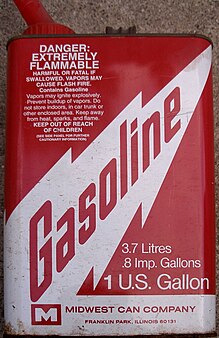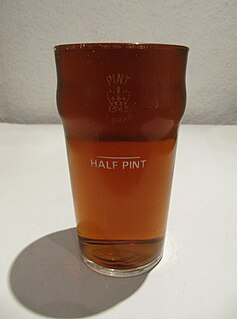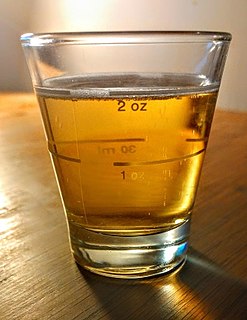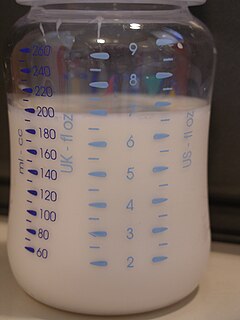
The gallon is a unit of measurement for volume and fluid capacity in both the US customary units and the British imperial systems of measurement. Three significantly different sizes are in current use: the imperial gallon defined as 4.54609 litres, which is used in the United Kingdom, Canada, and some Caribbean nations; the US gallon defined as 231 cubic inches or about 3.785 L, which is used in the US and some Latin American and Caribbean countries; and the least-used US dry gallon defined as 1/8 US bushel (4.405 L).

A hogshead is a large cask of liquid. More specifically, it refers to a specified volume, measured in either imperial or US customary measures, primarily applied to alcoholic beverages, such as wine, ale, or cider.

The system of imperial units or the imperial system is the system of units first defined in the British Weights and Measures Act of 1824, which was later refined and reduced. The Imperial units replaced the Winchester Standards, which were in effect from 1588 to 1825. The system came into official use across the British Empire. By the late 20th century, most nations of the former empire had officially adopted the metric system as their main system of measurement, although some imperial units are still used in the United Kingdom, Canada and other countries formerly part of the British Empire. The imperial system developed from what were first known as English units, as did the related system of United States customary units.

The pint is a unit of volume or capacity in both the imperial and United States customary measurement systems. In both of those systems it is traditionally one-eighth of a gallon. The British imperial pint is about 20% larger than the American pint because the two systems are defined differently. Almost all other countries have standardized on the metric system, so the size of what may be called a pint varies depending on local custom.
The quart is an English unit of volume equal to a quarter gallon. It is divided into two pints or four cups. Historically, the exact size of the quart has varied with the different values of gallons over time and in reference to different commodities. Presently, three kinds of quarts remain in use: the liquid quart and dry quart of the US customary system and the imperial quart of the British imperial system. All are roughly equal to one metric litre.
The minim is a unit of volume in both the imperial and US customary systems of measurement. Specifically it is 1⁄60 of a fluidram or 1⁄480 of a fluid ounce. In the Pharmacopoeia, it is also noted that the minim was originally created by Mr Timothy Lane, F.R.S., as 61440 parts per wine gallon.

A fluid ounce is a unit of volume typically used for measuring liquids. Various definitions have been used throughout history, but only two are still in common use: the British Imperial and the United States customary fluid ounce.

A bushel is an imperial and US customary unit of weight or mass based upon an earlier measure of dry capacity. The old bushel was equal to 2 kennings (obsolete), 4 pecks or 8 dry gallons and was used mostly for agricultural products such as wheat. In modern usage, the volume is nominal, with bushels denoting a mass defined differently for each commodity.

A barrel is one of several units of volume applied in various contexts; there are dry barrels, fluid barrels, oil barrels and so on. For historical reasons the volumes of some barrel units are roughly double the volumes of others; volumes in common usage range from about 100 to 200 litres. In many connections the term "drum" is used almost interchangeably with "barrel".

A barrel, cask, or tun is a hollow cylindrical container, traditionally made of wooden staves bound by wooden or metal hoops. Traditionally, the barrel was a standard size of measure referring to a set capacity or weight of a given commodity. For example, in the UK a barrel of beer refers to a quantity of 36 imperial gallons. Wine was shipped in barrels of 119 litres.

A keg is a small barrel.
The tun is an English unit of liquid volume, used for measuring wine, oil or honey. Typically a large vat or vessel, most often holding 252 wine gallons, but occasionally other sizes were also used.
English units are the units of measurement that were used in England up to 1826, which evolved as a combination of the Anglo-Saxon and Roman systems of units. Various standards have applied to English units at different times, in different places, and for different applications.

Both the imperial and United States customary systems of measurement derive from earlier English systems used in the Middle Ages, that were the result of a combination of the local Anglo-Saxon units inherited from German tribes and Roman units brought by William the Conqueror after the Norman Conquest of England in 1066.
Capacities of wine casks were formerly measured and standardised according to a specific system of English units. The various units were historically defined in terms of the wine gallon so varied according to the definition of the gallon until the adoption of the Queen Anne wine gallon in 1707. In the United Kingdom and its colonies the units were redefined with the introduction of the imperial system whilst the Queen Anne wine gallon was adopted as the standard US liquid gallon.
A wine gallon is a unit of capacity that was used routinely in England as far back as the 14th century, and by statute under Queen Anne since 1707. Britain abandoned the wine gallon in 1826 when it adopted imperial units for measurement. The 1707 wine gallon is the basis of the United States' gallon, as well as other measures.
Capacities of brewery casks were formerly measured and standardised according to a specific system of English units. The system was originally based on the ale gallon of 282 cubic inches. In United Kingdom and its colonies, with the adoption of the imperial system in 1824, the units were redefined in terms of the slightly smaller imperial gallon. The older units continued in use in the United States.

The imperial system of measurement and the US customary system of measurement are both derived from an earlier English system of measurement which in turn can be traced back to Ancient Roman units of measurement, and Carolingian and Saxon units of measure.
An Anker was a Dutch unit of capacity for wine or brandy equal to 10 US gallons that was used as a standard liquid measurement. It was most commonly used in Colonial times in New York and New Jersey, thanks to the earlier Dutch settlement of New Amsterdam.
A number of units of measurement were used in South Africa to measure quantities like length, mass, capacity, etc. The Imperial system of measurements was finally made standard in 1922. The metric system was adopted in 1970 in South Africa.












